 |
|||||||||
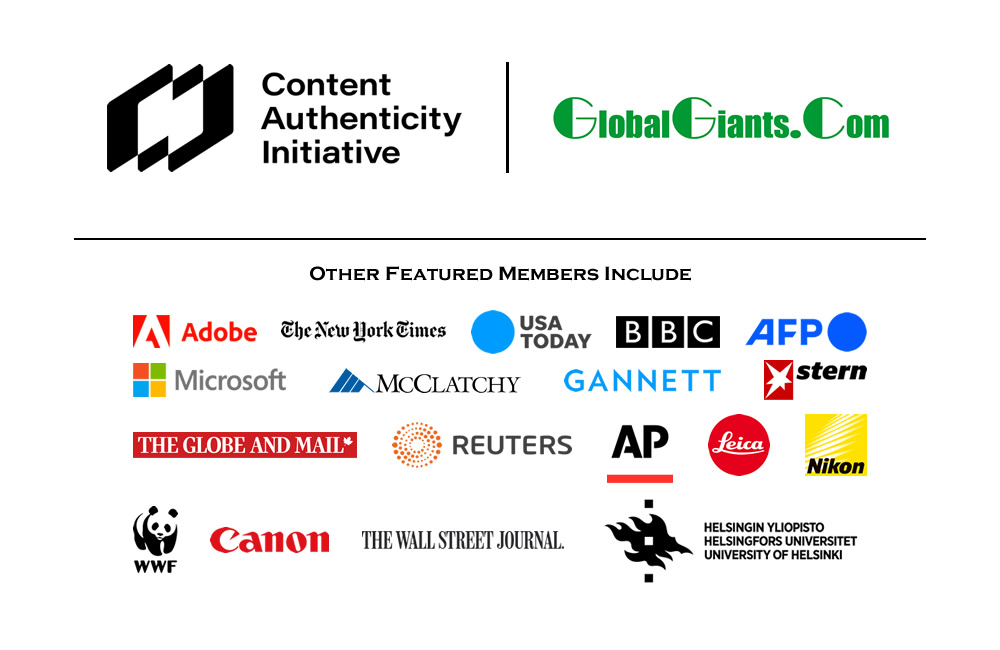



 |
|||||||||




Companies Must Ignore Fear, Make Smart Moves to Emerge Stronger.

In a recent survey conducted by Frost & Sullivan, the Growth Partnership Company, 91% of CEOs blame the breadth and depth of the current economic situation on the media.
"The media's manipulation of statistics, negativity, exaggeration, and doomsday forecasts have driven fear and panic among consumers and businesses alike," says David Frigstad, Chairman of Frost & Sullivan.

According to Frost & Sullivan, "Economic statistics are often twisted and exaggerated. The fear of total economic collapse is perpetuated in the media to grab attention and sell more copies or attract more viewers or listeners. Because of this, consumers and business have frozen spending, canceled projects, sold investments, and laid off workers. This has caused a downward spiral in demand and pricing that has now caused about 20 trillion dollars of damage globally."
"As the media continues to perpetuate fear, uncertainty and doubt, there is a growing chance that it will result in a self-fulfilling prophecy," adds Frost & Sullivan Economist Sandeep Maheshwari.
"What clearly started out with financial mismanagement and fraud on Wall Street has now escalated into a major global recession exacerbated by the media," says Frost & Sullivan's research. "CEOs cite how the media has continued to drive fear through efforts to gain more readers, viewers, and listeners. The ironic turn is that the media is also being victimized by the current recession, with declining audiences and falling ad revenues."
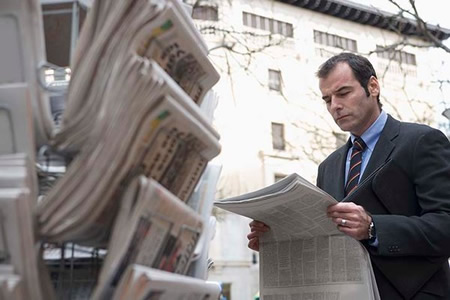
In the responses portion of the study, CEOs made several interesting comments:
• "Several newspapers have compared the overall job losses to the Great Depression without taking into account the huge increase in U.S. population since that time. These comparisons only generate more fear and are counter-productive."
• "Economists miss every turn in the economy. Why do we rely on their forecasts today when they are so unreliable? They move like a herd of antelope -- their current forecasts all fit nicely into a pack."
• "I recently read a headline that said Microsoft will lay off 5,000 workers. At the end of the piece it mentioned it would be over a three year period. Compared to the overall size of Microsoft, this is not newsworthy."
"We are now at a turning point. An unprecedented global stimulus plan and guaranteed programs are now in place. All of these trends could signal the turning point if we change our outlook. The media, economists, politicians, bankers, and business executives could collectively turn the economy around by working simultaneously to restore confidence back into the system -- in turn, calming the public. It's time for us to give up on the doom and gloom," concludes Frigstad.
|GlobalGiants.com|
Edited & Posted by the Editor | 11:18 AM | View the original post

A record number of automotive dealerships closed in the United States during 2008. This was revealed today by Urban Science.
(From its headquarters in Detroit, and from its offices in the United States, Spain, United Kingdom, Germany, Italy, France, Australia, China, Mexico and Japan, Urban Science serves global clientele by helping them identify where they should allocate resources to increase marketshare and profitability. Urban Science maintains a list of current new vehicle dealership and franchise information for all car and light truck brands in the United States. Compiled on a monthly basis, the census, according to it, is a reliable source of dealership statistics.)
The company's Franchise Activity Report, which, according to it, is the USA's most accurate data on dealers, showed the nationwide dealership count for the year fell by 881, or 4.2 percent, to 20,084. The decline was the largest since 1991 when data was first collected, with the bulk of closures occurring in the fourth quarter.
According to John Frith, vice president at Urban Science, the decline in automotive franchises was less than brick-and-mortar dealerships, implying consolidation. "There has been a loss of franchises across all the manufacturers, but the Detroit Three have been hit the hardest, accounting for 80 percent of the loss," Frith said. "We'll see even more contraction in the next several years as the Detroit Three strategically rethink their retail counts and locations."
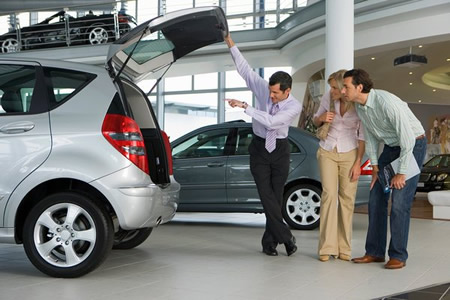
Proactive consolidation, a process in which an automaker closes a dealership or consolidates it with other nearby franchises, can be complex and expensive. To close down a retailer, state franchise laws and individual sales-and-service agreements must be honored. Automakers must provide compensation for dealer investments, such as new-vehicle inventory, special tools and resalable parts.
"When closing a dealer, the main focus for the automaker is to minimize the negative impact on the dealer and ensure customers can still be conveniently serviced," Frith added.
According to Randy Berlin, global practice director for Urban Science, proactive consolidation is the preferred method, but the market itself will force some dealers to shut their doors.
"The credit crunch is a two-pronged attack on dealers -- they can't get credit lines to secure new-vehicle inventory, and customers can't get credit to buy those vehicles," said Berlin. "However, most dealers will be able to weather the storm by reducing variable expenses and focusing on service and parts."

Urban Science's Franchise Activity Report, a subset of Urban Science's monthly Automotive Dealer Census, analyzes dealership data on national, state and market levels.
Other findings include:
• Colorado, Alaska, Hawaii, North Dakota and Montana were the only states that did not suffer declines in their dealership count.
• Rhode Island, California and Massachusetts experienced the largest percentage declines.
• Denver; Colorado Springs, Colo.; Raleigh, N.C.; and Greensboro, N.C. either added dealerships or had no declines.
• Five of the top 10 cities with the highest percentage declines were in California.
"We will continue to see proactive dealer closures in metro markets," said Berlin. "Rural markets, however, will likely withstand consolidation efforts. When people talk about the number of Detroit Three dealerships versus import brands, the Detroit Three do have more. Actually, more than 90 percent of brands in non-metro areas are from the Detroit Three. Ford, Chrysler and GM serve the rural areas well, and don't have much competition from foreign automakers."
Source: Urban Science
|GlobalGiants.com|
"We are encouraged by Chrysler's restructuring plan. It's comprehensive and realistic and viable. What's most important, however, is that Chrysler recognizes that availability of credit for automotive consumers and dealers is the single most important element of Chrysler's viability."
-- National Automobile Dealers Association
"General Motors has submitted a strong plan. It's comprehensive and aggressive and achievable. We are, of course, exceedingly disappointed that a viable solution has not yet been found for Saturn, Saab and Hummer. When considering the future viability of these brands, GM should continue to aggressively pursue all options. We are pleased that GM recognizes the 'great dealer network' that supports these brands. Should it become necessary to phase out these brands, it is imperative that GM treat the affected dealers fairly and that they be properly compensated. It is equally important to take care of the Saturn, Saab and Hummer owners. On the positive front, we are encouraged that GM recognizes that the availability of credit for automotive consumers and dealers is central to GM's survival."
-- National Automobile Dealers Association
"Respect your Dealers. Work for your Dealers.
And the God of Marketing & Sales will Respect You and Work for You."
© GlobalGiants.Com
Edited & Posted by the Editor | 12:21 PM | View the original post
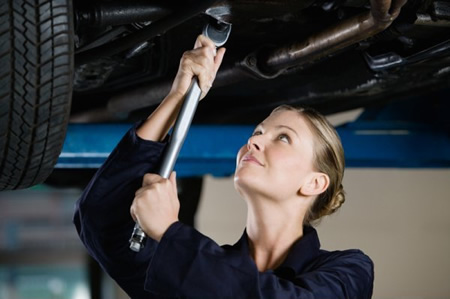

U.S. House of Representatives Speaker Nancy Pelosi and Financial Services Chairman Barney Frank have sent the following letters to Robert L. Nardelli, Chairman and CEO of Chrysler, and Rick Wagoner Jr., Chairman and CEO of General Motors, regarding their company restructuring plans, which are due next week.
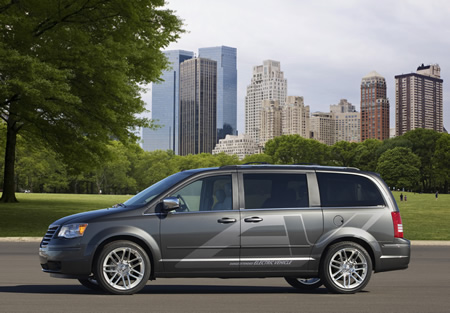
Photo: Chrysler Town & Country EV
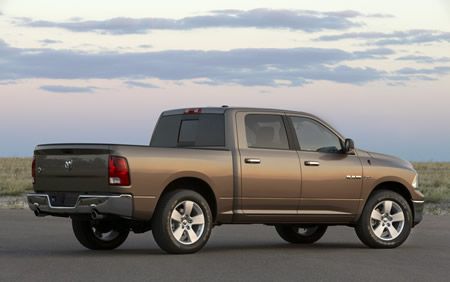
Photo: Chrysler 2009 Dodge Ram 1500
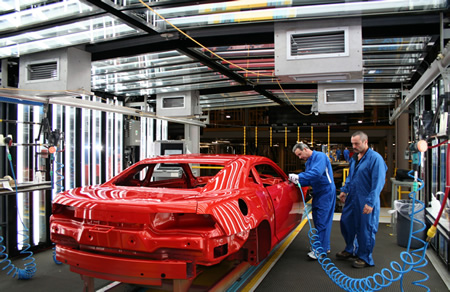
Photo: GM 2010 Chevrolet Camaro Build
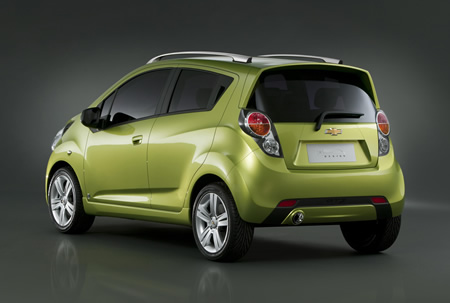
Photo: GM 2010 Chevrolet Spark
In the letter, Pelosi and Frank write: "We trust that your restructuring plan will demonstrate to the world that you are willing to make the tough decisions that modernize your operations, restructure your debt, enhance your competitive status in the global marketplace, and protect American jobs for the future."
Below is the full text of the letter:
February 13, 2009
Mr. Robert L. Nardelli
Chairman and CEO
Chrysler LLC
1000 Chrysler Drive
Auburn Hills, MI 58326
Mr. G. R. Wagoner, Jr.
Chairman and CEO
General Motors Corporation
300 Renaissance Center
MC 482-C39-B50
Detroit, MI 48265-3000
Dear Mr. Nardelli and Mr. Wagoner:
As the February 17 deadline approaches for the automobile companies to submit restructuring plans to the federal government, we are writing to stress the importance of your submitting a credible restructuring plan that results in a viable industry, with quality jobs, and economic opportunity for the 21st century, while protecting taxpayer investments.
In October of last year, Congress approved the Bush Administration's request to provide $700 billion in taxpayer assistance to stabilize the financial system, following warnings by the Administration that inaction would lead to a financial catastrophe. The Bush Administration's lack of transparency in implementing this initiative, and its failure to address the foreclosure crisis head-on (the root cause of the financial crisis), resulted in significant public skepticism about large-scale government interventions to rescue private corporations.
Amidst this public skepticism, the House of Representatives in December passed legislation that authorized taxpayer assistance to the auto industry. This legislation, which the Senate failed to pass, served as the basis for the Bush Administration's December initiative to provide loans to the automobile industry from the TARP.
Mindful that 1 in 10 American jobs is related to auto manufacturing, our national security depends on the industry's technologies and manufacturing capacity, and our competitiveness in the global economy depends on its pursuit of excellence.
Though we recognize that our economy faces significant challenges, Congress and the American people believe that your restructuring plan must include the following:
A documented assessment of your company's ability to ensure long-term viability as you retool for the future, including a target market size;
A commitment that the sacrifices necessary to turn the industry around will be shared equitably by all stakeholders;
A commitment to protecting and sustaining the health and pension benefits that have defined "quality" American jobs and allowed millions to enter the middle class;
A demonstrated commitment to restructure your company's debt in a manner that protects the interests of the taxpayers;
An additional assurance that taxpayers benefit as corporate conditions improve and shareholder value increases; and,
A demonstration of your ability to achieve or exceed the fuel efficiency requirements set forth in the Energy Independence and Security Act of 2007, and the emissions standards adopted by California and other states, if they receive Federal approval, and become a long-term global leader in the production of fuel-efficient and advanced technology vehicles.
We trust that your restructuring plan will demonstrate to the world that you are willing to make the tough decisions that modernize your operations, restructure your debt, enhance your competitive status in the global marketplace, and protect American jobs for the future. Thank you for your consideration of this matter.
best regards,
NANCY PELOSI
Speaker of the House Chairman
BARNEY FRANK
Financial Services Committee
Source: Office of the Speaker of the U.S. House of Representatives
|GlobalGiants.Com|
Edited & Posted by the Editor | 10:38 AM | View the original post
JWT, one of the largest advertising agencies in the world, has released its list of 90 things to watch in 2009.

"Our list points to the broader trends we're seeing, showing the ways in which these shifts will manifest in our everyday lives," says Ann Mack, director of trendspotting at JWT. Among these shifts, the recession will make the biggest impact, says Mack. "A lot of what to watch in 2009 relates to consumers' adaptation to the economic situation, from 'affordable nutrition' to 'more under one roof,'" notes Mack.

JWT's list of 90 Things to Watch in 2009 (unranked and in alphabetical order):
1. 21st-Century Networking
2. Affordable Nutrition
3. Amy Poehler
4. Apatow-esque Humor
5. Bruno
6. Building a Beauty Arsenal
7. Buraka Som Sistema
8. Career Reinvention and Extension
9. Chat-Avoidance Services
10. The Cleveland Show
11. Cloud Computing
12. The Collective Consciousness
13. Creativity in the Informal Economy
14. Credit Card Dieting
15. Crowdfunding
16. The Decline of E-Mail
17. Distraction as Entertainment
18. DIY Repairs and Renovations
19. Doha
20. Dragonball
21. EarthRoamer
22. Electric Bikes
23. Elizabeth Banks
24. Emma Stone
25. The Energy Race
26. Environmental Exercise
27. Family-Friendly TV
28. Freebies
29. Gerard Butler
30. Girl Talk
31. Giving Circles
32. Gluten-Free
33. Good Old-Fashioned Cooking
34. Graphic Novels Hit Hyperdrive
35. The Green-Collar Class
36. hi5
37. Holographic Projection
38. Home as Castle
39. HomeAway
40. Homemade Beauty Treatments
41. How to Talk to Girls
42. Incognito luxury
43. Inconspicuous Travel
44. Innocent Cosmetics
45. Lady GaGa
46. Lala.com
47. Lance Armstrong
48. Lykke Li
49. Maria Pinto
50. Marketing with Aromas
51. Michelle Obama
52. Microfinancing's Second Wave
53. Mobile Phones Get Personal
54. More Under One Roof
55. NASA's Kepler Telescope
56. Netbooks
57. Noor
58. No "Paper" in Newspapers
59. Nutrition Replaces Dieting
60. Obama-speak
61. ODO7
62. Online TV Network Crackle
63. Online Video Ads
64. Outliers (as a term)
65. Palin's Grandson
66. Personalized Travel Guides
67. Pisco Sours
68. Presidential Sightseeing
69. Prince William Wedding Watch
70. Product Source Tags
71. Radical Transparency Meets Genomics
72. Readers + Social Media = Revenue?
73. Residential Market for Solar Power
74. Ricky Rubio
75. Russell Brand
76. Safe-keeping
77. The Small Movement
78. Smart Garages
79. South Africa
80. Stuart Karten
81. Sustainable Fishery
82. T. Boone Pickens
83. Telepresence
84. Touch Screens
85. Twitter Copycats
86. Virtual Reality Therapy
87. Virtual Socializing
88. Widgets
89. Wikileaks
90. Xbox Streaming
Headquartered in New York, JWT is a global network with more than 200 offices in over 85 countries employing nearly 10,000 marketing professionals. JWT's parent company is WPP and its clients include Bayer, Cadbury, Diageo, DTC, Ford, HSBC, Johnson & Johnson, Kellogg's, Kimberly-Clark, Kraft, Nestle, Nokia, Rolex, Schick, Shell, Unilever, and Vodafone.
Source: JWT
U.S. Federal Government has done all it can currently do to sustain the ailing domestic (as well as global) economy.
It is a crime to put all the blame on the managements of the bankrupt or struggling American corporations and make them scapegoats.
The blame must be shared by all those who have been blind to (or unaware of) the Highest Law of Economics and have been advertently or inadvertently contributing towards the propagation of the easy-money excessive greed culture originating in the USA.
Such contributors include the Top American Business & Financial Newspapers & Magazines, Relevant Leading Advertising Agencies, and some Industry Specific Labor Unions.
© GlobalGiants.Com
Edited & Posted by the Editor | 12:18 PM | View the original post
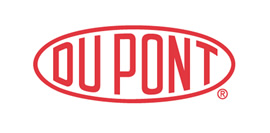
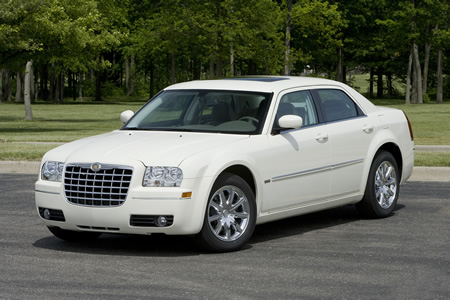
Photo: The 56th annual DuPont Color Popularity report show white and white pearl coat remain the top color choice for North American consumers for the second year in a row.
The just published 2008 DuPont Automotive Color Popularity Report says white is the top vehicle color choice in North America for the second straight year, and is a strong player globally, with "white effects" allowing consumers to differentiate cars subtly to express their individuality. Black and silver with effects also turned in a strong performance globally. The term "effects" refers to special pigments that lend a pearl or iridescent appearance to coatings.
White and white pearl scored 16 and 4 percent, respectively, black and black effect scored 11 percent and 6 percent, while silver, which led the pack for six consecutive years, garnered a 17 percent share of the North American market.
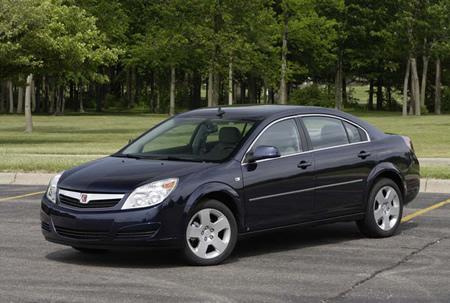
Photo: Blue hues, such as seen in the Saturn Aura, are increasingly popular according to the 2008 DuPont Automotive Color Popularity Report
A leading supplier of coatings to the global automotive market both for new cars and in the collision repair industry, DuPont this year broadened the global scope of the authoritative Automotive Color Popularity Report to include specific data from emerging markets India and Russia. The automotive industry is expanding rapidly in both countries.
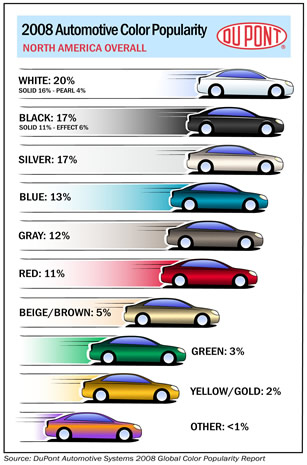
North American color choice highlights several trends. First, there is a continuing convergence of color choice globally with color preferences becoming more homogeneous across the globe. Additionally, DuPont continues to report white as a "palette cleansing" color signaling a pause after a long running trend and in advance of a new trend. The 2007 DuPont Automotive Color Popularity Report announced the end of silver's seven year reign.
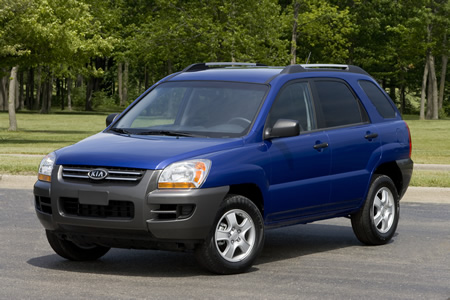
Photo: Blue hues, such as seen in the Kia Sportage, are increasingly popular according to the 2008 DuPont Automotive Color Popularity Report
"We're seeing basic colors like black, white and silver continuing in the lead but consumers are looking for differentiation with tri-coat and other effects," said Karen Surcina, color marketing manager -- DuPont Performance Coatings. "These colors and effects provide a higher degree of customization and luxury-effect which allow consumers a conservative differentiation from the traditional color palette." A tri-coat paint system consists of a basecoat, a midlayer which contains the color and specialized "effect" pigments followed by a clear coat.
"While black, white and silver continue to remain strong, we are seeing interesting trends developing," Surcina continued. "The popularity of true chromatic colors such as blue and red are on the rise, with blue growing worldwide as consumers look to more environmental themes and lifestyles."

Photo: The 2008 DuPont Automotive Color Popularity Report shows a strong preference across the globe for black effect colors, like the Black Magic on the 2009 Volkswagen GTI, which provides a unique customized appearance.
"Blue is being utilized as the 'new green' because it is well understood by people all over the world that blue can also represent the preservation of nature," said Leatrice Eiseman, executive director of the Pantone Color Institute and author of Color: Messages and Meanings. "Imagine a clear blue sky mirrored in a pristine blue lake and you will get the picture. It is a universal favorite."
Global Convergence and Regional Differentiation
The global review of color popularity reveals that preferences are converging around the world, but within the convergence there is subtle differentiation between markets. As DuPont reported in June 2008, blue is becoming more popular, and currently ranks among consumers in North America with 13 percent of the overall market. Blue has garnered 12 to 13 percent of the market for the past few years and is a top five color choice in every market with the exception of Brazil.
"Neutral colors like silver and light gray shades capture a high volume, but long term they show a decreasing tendency in almost all regions," said Nancy Lockhart, DuPont color designer for North America. "Moving forward, it will be imperative to refresh styling of these popular colors with different effects that can restore their popularity."
Europe
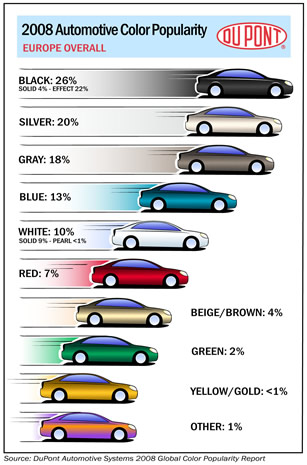
Europe is dominated by the popularity of black vehicles in all segments. Black with effect, white/white pearl and silver are most popular across the board with a rise in bright reds in this year's report. The rankings remain consistent for black/black effect with 26 percent of the market, silver with 20 percent and gray with 18 percent.
White/white pearl saw a slight increase in popularity, rising from 8 percent last year to 10 percent in 2008. The warm neutral tones of beige and brown regained popularity in 2008, reaching 4 percent -- up from 2 percent last year.
"Current preferences are strongly influenced by ecological concepts, with demand growing for light, pure and sophisticated looks and the strength of blue showing optimism for the future," said Elke Dirks, DuPont color designer for Europe. "In the long term, we believe that European consumers will ask for a more colorful and individualistic palette from car makers."
Russia
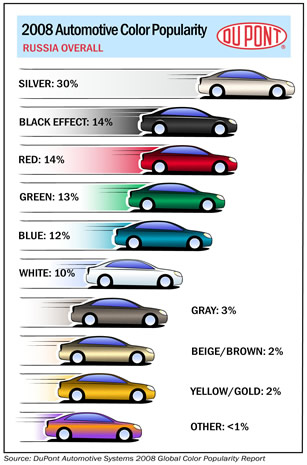
Russian color preference shows an overwhelming use of silver at 30 percent, black and red at 14 percent and slight differences between green (13 percent), blue (12 percent) and white (10 percent). Though Russia leans toward the silver and black color spaces, red and green are more popular there than in any other region, demonstrating the diversity of color trends.
Asia
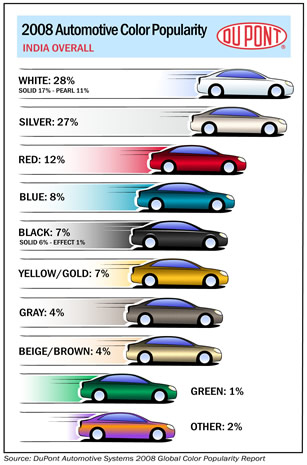
India's market shows a strong preference toward white and white pearl with 17 and 11 percent respectively, followed by silver with 27 percent. As in Russia, strong chroma colors made a good showing with red at 12 percent and blue at 8 percent. Black and black effect with 6 percent and 1 percent, respectively, was even with yellow and gold at 7 percent.
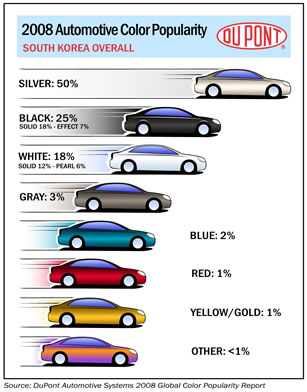
Silver remains exceptionally strong in the Asian countries of China, South Korea, Japan and India. In South Korea silver represents 50 percent of the market, up from 39 percent last year. Silver is the top color with strong growth shown in China as well at 32 percent for 2008, up from 23 percent in 2007. Japan and India report white/white pearl in the top color position (8 and 24 percent and 17 and 11 percent, respectively) with silver making a strong showing with 28 percent in Japan and 27 percent in India.
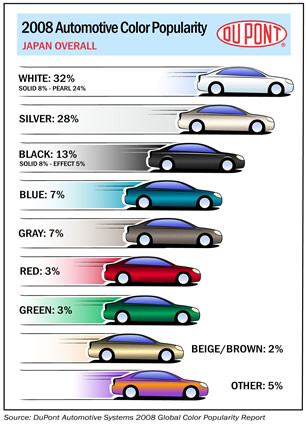
"Candy white and tri-coat pearl are extremely popular in most of the Asia Pacific area," said Emily Hung, DuPont color designer for the Asia Pacific region. "In Japan we see an overwhelming preference for white pearl or white with effect.
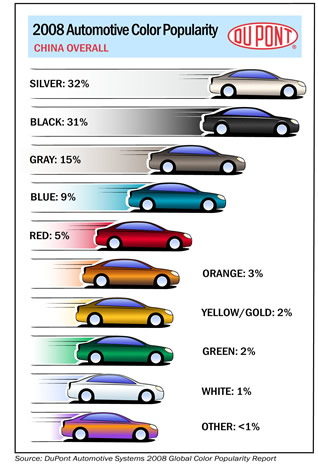
"In India and China we see a wide range of colors offered to attract young buyers to compact cars," Hung said. "Additionally, dark blue metallic is popular and we're fine-tuning a variety of shades for the region."
Mexico and Brazil
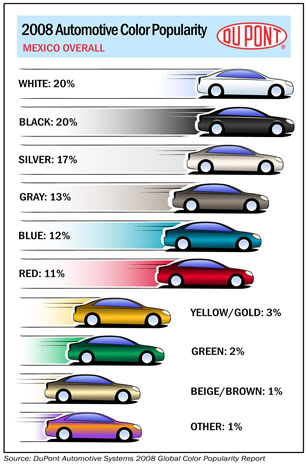
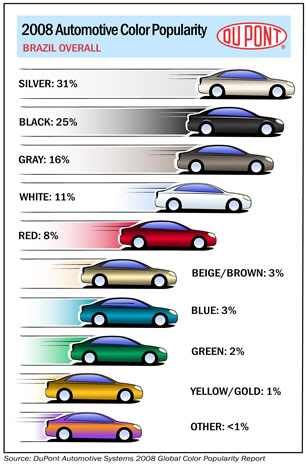
White and black are tied for the most popular color in Mexico at 20 percent each, with silver at 17 percent and gray at 13 percent. Following these cool-neutral shades, blue shows strength with 12 percent and red follows at 11 percent. Neutral spaces dominate Brazil with silver (31 percent), black (25 percent), gray (16 percent) and white (11 percent). Red is the most popular chroma color with 8 percent of the market.
DuPont "Time for Color" Trend Show
"Time for Color" is the theme of this year's DuPont global color trend forecast for the auto industry. Time is an important factor in the evolution of color. Consumers are increasingly focused on individuality, expressive car designs, small vehicles and fuel economy. These elements require innovative shades for a futuristic view of technology as it evolves. DuPont presents its annual trend show to automotive designers globally to showcase new trends, color availability and the new coatings technologies available to the market.
Source: DuPont
|GlobalGiants.com|
Edited & Posted by the Editor | 11:29 AM | View the original post
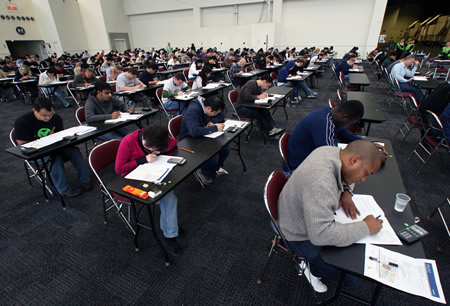
Photo: In New York's Jacob K. Javits Convention Center, November 15, several hundred financial risk manager certification candidates taking the 6-hour Financial Risk Manager (FRM(R)) Exam offered by the Global Association of Risk Professionals (GARP).
Yesterday, on November 15, at 9 am local time in each of 78 cities around the world, a record-breaking total 13,681 financial professionals were registered to take the annual Financial Risk Manager (FRM(R)) certification exam offered by the Global Association of Risk Professionals. From New York to Hong Kong, the 6-hour exams were taken at testing centers located in major cities across six continents including Mumbai, Beijing, Jakarta, Tokyo, Singapore, Seoul, Bangkok, London, Paris, Warsaw, Frankfurt, Istanbul, Dublin, Stockholm, Tel Aviv, Dubai, Melbourne, Sydney, Johannesburg, Montreal, Toronto, Dallas, Seattle, Honolulu and many others.
The Global Association of Risk Professionals (GARP) is a not-for-profit independent association of close to 100,000 risk management practitioners and researchers representing banks, investment management firms, government agencies, academic institutions, and corporations from more than 167 countries worldwide.
There were 500 candidates registered to take the exam in New York, 1,700 in Hong Kong and 1,100 in Mumbai, reflecting the significant and growing global attention to the practice of financial risk management," said Richard Apostolik, GARP President and CEO. "FRM certification has become the gold standard for financial risk managers to objectively demonstrate real world competence in their profession, and the FRM certification program is helping to expand industry-wide understanding of financial risk management best practices, concepts and theories," he added.
|GlobalGiants.com|
Edited & Posted by the Editor | 2:40 AM | View the original post
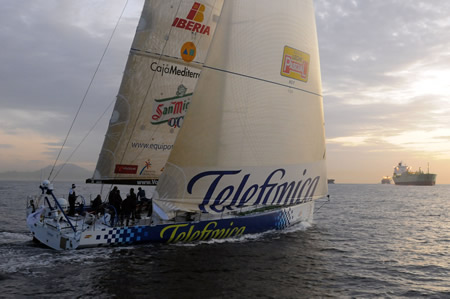
Photo: Telefonica Blue officially suspended racing having reached landfall near Gibraltar to undertake repairs to the steering gear they damaged soon after the race start in Alicante. (© Dave Kneale/Volvo Ocean Race)
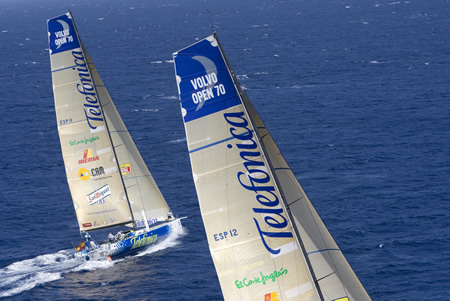
Photo: Telefonica Blue and Black training off Alicante. (© Maria Muina/Equipo Telefonica)
The Volvo Ocean Race 2008-09 is the 10th running of this ocean marathon. Starting from Alicante in Spain, on 4 October 2008, it is, for the first time, taking in Cochin, India, Singapore and Qingdao, China before finishing in St Petersburg, Russia for the first time in the history of the race. Spanning some 37,000 nautical miles, visiting 11 ports over nine months, the Volvo Ocean Race is the world's premier ocean yacht race for professional racing crews.
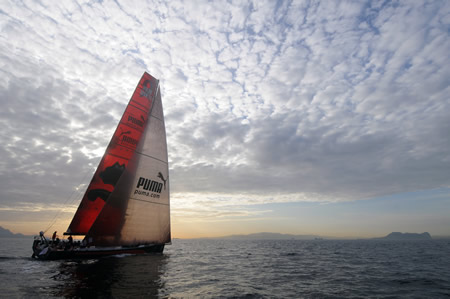
Photo: PUMA Ocean Racing heads into the Gibraltar strait during leg 1 of the Volvo Ocean Race. (© Dave Kneale/Volvo Ocean Race)
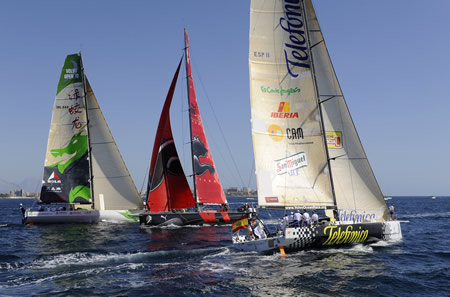
(Photo © Rick Tomlinson/Volvo Ocean Race)
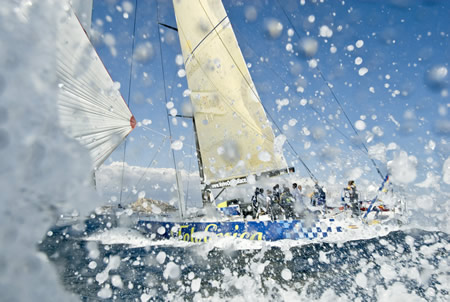
Photo: Telefonica Blue sail testing off Alicante, prior to the in-port race. (© Rick Tomlinson/Volvo Ocean Race)
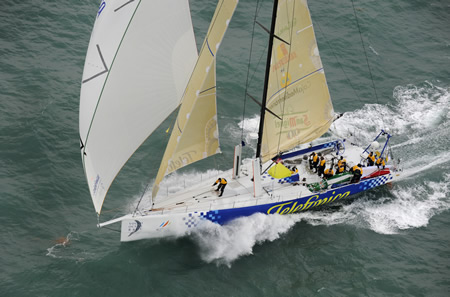
Photo: Telefonica Blue breaks away from the start line in Alicante, Spain for leg 1 of The Volvo Ocean Race. Next is a 6,500nm battle to Cape Town, South Africa. (© Rick Tomlinson/Volvo Ocean Race)
The Volvo Ocean Race is an extreme sport, where boats, equipment and crew push the limits at very high speeds, over very long distances and out of reach for any coast guard. Since Volvo bought the race in 1997, safety has been improved for each race.
A new design of boat, the Volvo Open 70, was introduced for the 2005-06 event. It is faster and more dynamic than any boat previously sailed in the race. This state-of-the-art class of boat, with canting keel and a sail area as large as three tennis courts is being used again in this race, with some slight modifications.
Each Volvo Open 70 has two Volvo Penta engines onboard that are provided by Volvo. One is an engine that can propel the boat, the other creates electricity for all the equipment onboard: the navigation gear, the desalination device etc. The waste is stored onboard and is recycled in the ports.
All major sport events face similar environmental challenges. Therefore, a major United Nations conference on sport and the environment was held in Alicante in conjunction with the start of Volvo Ocean Race. The conference focused on how to make global sport events more sustainable.
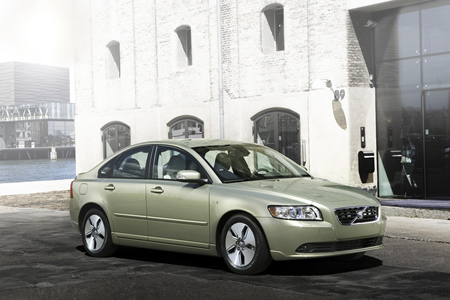
Photo: Volvo S40, Gekko Green
According to Volvo Car Corporation, in Volvo Cars' brand value pyramid, (1) Safety is followed by (2) Care for the Environment and (3) Modern Scandinavian Design, and all these three brand values are tied into Volvo Ocean Race as well.
|GlobalGiants.com|
Edited & Posted by the Editor | 10:44 AM | View the original post
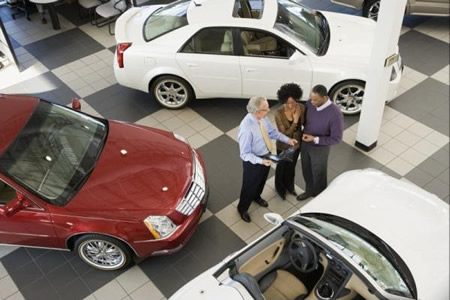
According to J.D. Power and Associates Report released today, as the U.S. new-vehicle retail market continues to deteriorate, new-vehicle retail sales are projected to end 2008 at 10.8 million units, which is 2 million units below 2007 sales.
Approximately two-thirds of the decline in retail sales -- which are reflective of actual consumer behavior in the new-vehicle marketplace -- can be attributed to consumers delaying vehicle purchases. On average, consumers are keeping their vehicles 4 months longer in 2008 compared with 2007 -- up from 67 months to 71 months. The remaining one-third of the volume decline comes from reduced leasing activity. Additionally, fleet sales are expected to decline to 2.8 million units in 2008, which is well below the 3.3 million unit level achieved in 2007.
"Buyers are both voluntarily and involuntarily exiting the U.S. new-vehicle market," said Jeff Schuster, executive director of automotive forecasting for J.D. Power and Associates. "The additional decline in expected vehicle sales is a function of growing concerns around availability of credit and leasing, declines in vehicle equity and general economic stress."
The current turmoil and financial crisis adds risk to the 2008 forecast of up to 200,000 units, as it is unclear how consumers will respond in the fourth quarter.
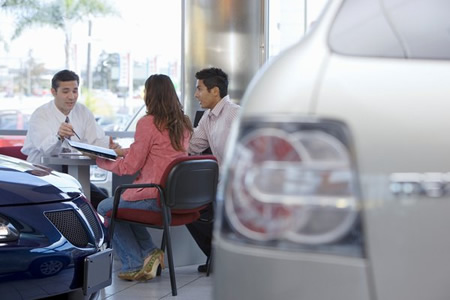
• Total U.S. Light-Vehicle Market:
(Light vehicles are defined as passenger cars, SUVs, MPVs and light commercial vehicles with gross vehicle weight of less than six tons.)
J.D. Power and Associates forecasts total new light-vehicle sales -- which includes both retail and fleet sales -- to drop to 13.6 million units in 2008, registering a 16 percent decline from 16.1 million units in 2007.
Market uncertainty has also led to a downward revision of the J.D. Power and Associates 2009 U.S. light-vehicle forecast. Total new light-vehicle sales are expected to drop to 13.2 million units in 2009, with the retail sales market declining to 10.6 million units.
"Falling trade-in equity, fewer leasing options, credit market restructuring and the increased migration to used vehicles are all putting added pressure on the U.S. new-vehicle sales market in 2009," said Schuster. "Any truly pronounced recovery appears to be more than 18 months away."
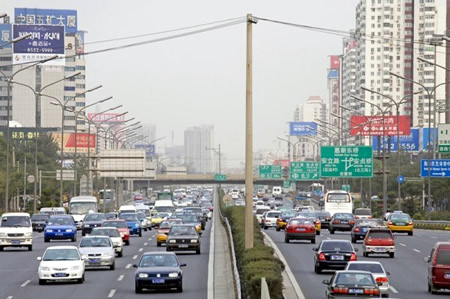
• China Light-Vehicle Market:
Slowing within China's automotive market is projected to intensify during the fourth quarter of 2008, and will likely lead to a downward revision for 2009. Despite the slowing, light-vehicle sales -- including passenger vehicle and light commercial vehicle segments -- in China are expected to reach 8.9 million units in 2008, which marks an increase of 9.7 percent from 2007. However, the projected growth rate for the China automotive market in 2008 is less than one-half of the 24.1 percent growth achieved in 2007.

• Indian Light-Vehicle Market:
The light-vehicle sales forecast has also been reduced for the India market, down 6 percent from the original forecast of 1.9 million units to 1.8 million units for 2008. The 5.1 percent growth rate forecasted for 2008 is considerably less than the increases demonstrated in 2007 (16%) and 2006 (21%).
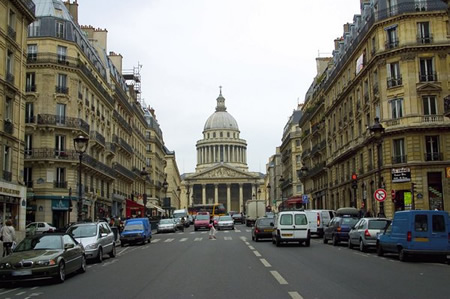
• European Light-Vehicle Market:
Light-vehicle sales in Europe are expected to fall to 21.3 million units in 2008, marking a 3.1 percent decline from sales in 2007. Within Western Europe, sales are forecasted to decline to 15.6 million -- a decrease of 7.5 percent from 2007. While sales in Eastern Europe are expected to increase to 5.8 million in 2008 -- up 11.3 percent from 2007, growth within the region is slowing considerably.
"While the global automotive industry is clearly experiencing a slowdown in 2008, the global market in 2009 may experience an outright collapse," said Schuster. "While mature markets are being impacted more severely than emerging markets, no country or region is completely immune to the turmoil."
Source: J.D. Power and Associates
|GlobalGiants.com|
Edited & Posted by the Editor | 2:59 PM | View the original post
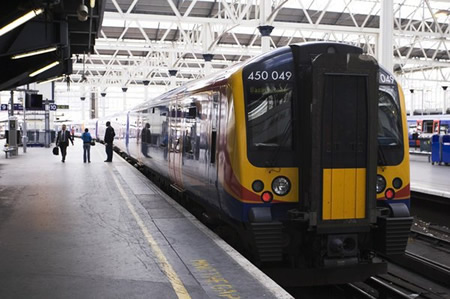
A U.S. mational survey shows that rather than wait for an electric car or better biofuels, millions of Americans are saving money and time by switching to public transportation.
According to this new nationwide survey commissioned by the HNTB Companies, more than 24 million Americans -- 11 percent of the adult population -- are using buses, light rail, commuter rail and other forms of public transportation more than they did last year. An even greater percentage of survey respondents, 16 percent, said they expect their ridership to increase in the coming year.
(The HNTB Companies is an organization of infrastructure firms. The three operating companies of HNTB Companies include HNTB Corporation, a transportation, engineering, planning and construction management firm; HNTB Architecture Inc., whose design professionals provide services to the buildings market; and HNTB Federal Services Corporation, which provides federal-sector clients diverse infrastructure services.)
"As today's Americans face increasing demands on their time and money, riding public transit is shifting from something they should do, like eating their vegetables, to something they want to do," said Peter Gertler, vice president and national director of public transit services for HNTB Corporation.
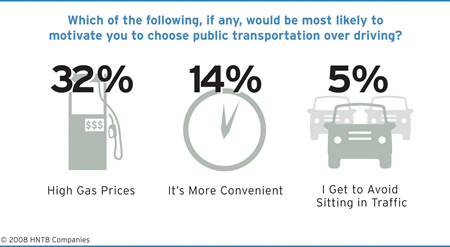
Nearly one in three Americans (32 percent) said their biggest motivator to choose public transportation over driving would be high gas prices. While conventional wisdom holds Americans would find it frustrating to give up the convenience of a car, the survey found the second most popular reason someone would choose public transportation over driving is more convenience (14 percent). Avoiding traffic (5 percent) was a distant third, followed by concern for the environment (4 percent).
"For more than 50 years, the automobile has ruled the transportation landscape," Gertler said. "Our interstate highways are aging and under tremendous strain, and we're seeing the costs of an unbalanced transportation system. Now more than ever we need to invest in multiple modes of transportation that address modern demands and preserve our quality of life."
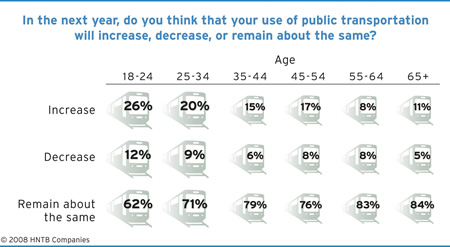
Gertler cited several benefits in a balanced approach to transportation that includes public transit:
• Saves time and conserves fuel -- 541 million hours and 340 million gallons, according to the Texas Transportation Institute's 2007 Urban Mobility Report.
• Saves money -- Americans living in areas served by public transportation save $18 billion annually in congestion costs.
• Promotes cleaner air -- Public transit usage reduces U.S. carbon emissions by 37 million metric tons a year, equivalent to the electricity used by 4.9 million households.
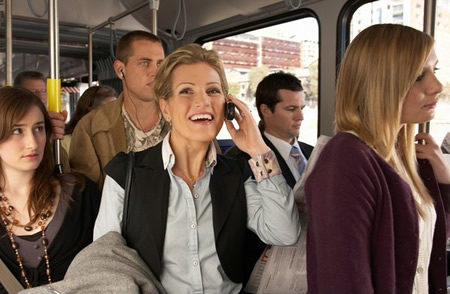
Measuring transit trends across the country, the survey also found:
• More than twice as many men as women (15 percent versus 7 percent) say they're using public transit more often than a year ago.
• Young Americans are making the transition in greater numbers. Nearly one in five adults ages 18-34 have increased their public transit usage in the last year (19 percent); that's more than twice the number of Americans ages 35 and up who can make the same claim (8 percent).
• The average American who has public transportation available to them uses it once a week, in effect giving their car the day off.
• Nearly four in ten Northeasterners (38 percent) use public transportation, more than any other region in the country.
• Southerners, however, have fewer options. One in ten says they do not have public transit where they live or work.
Source: HNTB Companies
|GlobalGiants.com|
Edited & Posted by the Editor | 10:06 AM | View the original post
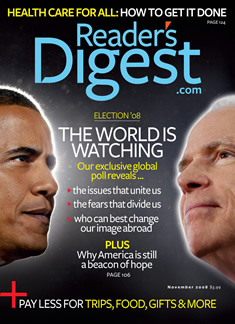
According to the results of a first-ever global presidential poll conducted by Reader's Digest magazine and published in the November issue (on newsstands October 21), Barack Obama is the world's preferred choice for president of the United States by far.
(Reader's Digest magazine is published in 21 languages and reaches 70 million readers worldwide. It is part of The Reader's Digest Association, Inc., a global multi-brand media and marketing company headquartered in Pleasantville, New York, USA.)
The poll, part of the cover story "How the World Sees Us" by Reader's Digest Washington Bureau Chief Carl Cannon, asked 17,000 people in 17 countries, including the United States, whom they would like to see in the White House, and to weigh in on the global issues they most care about. They were also asked to characterize how America is perceived abroad.
"For the first time, Reader's Digest used its unique international footprint to provide a tapestry of global perspectives on several of the most important issues of our time, leading with the election of the next American president," said Peggy Northrop, U.S. Editor-in-Chief, Reader's Digest.

• Regarding the question of which candidate they would vote for if they could, respondents voted overwhelmingly for Obama in every country polled, with the exception of the United States, where Republican John McCain was preferred over Democrat Obama by a narrow margin.
• "It's Obama by a landslide -- except in the country in which he's actually running for president," said John Fredricks, Director of Polling for Reader's Digest. "What is most striking is the margin of his support."
In the Netherlands, Obama-mania surpassed 90 percent. In Germany, it was at 85 percent--numbers not usually seen in political polling. Similar results held true on all six continents that the magazine polled.
One of the questions was "When you think of the U.S. government, do you consider yourself pro-American, neutral or anti-American?" The poll also asked respondents to rank eight issues in importance: terrorism, the war in Iraq, the global economy, global poverty, human rights, the environment, international trade, and nuclear proliferation.
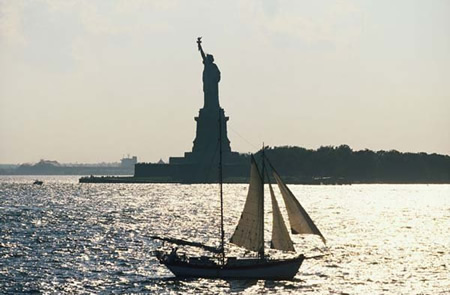
Key Snapshots:
• Americans ranked the global economy as most important; terrorism, second; and the war in Iraq, third. Only the Russians were more concerned with terrorism than Americans.
• In seven nations (Australia, Brazil, Canada, Finland, Germany, Great Britain and Taiwan), the environment came out on top as a major concern.
• Respondents in Canada, Germany, Netherlands, Finland, Australia, and South Africa reported paying the most attention to the U.S. election. Respondents in Brazil, Poland, Russia, India, and Taiwan reported paying the least attention.
• While preference for the candidates is nearly equal in the U.S., support for Obama is significantly stronger in all other nations.
• In the U.S., McCain is seen as more qualified to address issues related to war and security, while Obama is the stronger candidate for humanitarian issues, such as poverty, the environment and human rights.
• Globally, the most important issues are the economy, poverty, and the environment.
• The election of Obama would be more likely to improve the image of the U.S.
• Most countries polled have a neutral opinion of the U.S. government. India is the most pro-American government (31%) while Spain, Netherlands, Indonesia and Canada have the highest percent (21%, 21%, 20%, 19%) of respondents who are anti-American government.
• The majority in India (73%), South Africa (65%), the Netherlands (55%) and France (52%) would be interested in moving to the U.S. while about 70% of respondents in Poland, Russia, Indonesia, and Australia expressed a lack of interest in moving to the U.S.
• South Africa is the only country where the election of McCain would have a slightly more positive impact on the image of the U.S.
Source: Reader's Digest
"Well, also, was it written by Theologians: a King rules by divine right. He carries in him an authority from God, or man will never give it him. Can I choose my own King? I can choose my own King Popinjay, and play what farce or tragedy I may with him: but he who is to be my Ruler, whose will is to be higher than my will, was chosen for me in Heaven."
- Thomas Carlyle, Sartor Resartus
|GlobalGiants.com|
Edited & Posted by the Editor | 7:32 AM | View the original post

"The National Association of Realtors(R) is truly relieved that members of the U.S. House of Representatives, like their counterparts in the Senate, were able to come together in a bipartisan effort to pass the Emergency Economic Stability Act of 2008. As we have been saying, this legislation is critical to stopping the economic turmoil that millions of Americans are facing. Today's action will go a long way toward ending the current economic crisis crippling the housing and financial markets.
This legislation would quickly restore liquidity to the mortgage market, which would stabilize the housing market and protect homeowners. Mortgages as well as personal and small business loans would become more available and less costly. Protecting Main Street not only benefits individuals, families and communities, but also supports the larger U.S. economy.
We expect that the president will act quickly to sign and enact this bill. We thank President Bush for his steadfast leadership on this issue, commend all parties that worked on this legislation, and look forward to working together toward a strengthened economy for the benefit of all Americans."
- Richard F. Gaylord, President, National Association of Realtors. [National Association of Realtors, 430 North Michigan Avenue, Chicago, IL 60611, USA.]

"The House of Representatives' historic vote demonstrated leadership in difficult times. Americans and businesses, small and large, are already suffering financial challenges as a result of this crisis. This legislation is the first step in restoring liquidity in our economy. CPAs will roll-up our sleeves to do our part to help individuals and businesses move forward. The profession has already been actively reaching out through extensive financial literacy efforts to help Americans cope with the personal financial challenges they face.
The AICPA is pleased Congress avoided calls by some for an immediate suspension of fair value accounting rules. The bill includes a call for an objective study of mark-to-market accounting. We look forward to participating with the Securities and Exchange Commission and the Financial Accounting Standards Board in a thoughtful review.
Accounting standards are the keystone of our financial reporting system and are designed to provide investors and management with timely signals about the financial condition of our publicly-traded companies. Our longstanding position is that accounting standards ultimately should be set by the private sector."
- Barry Melancon, President, American Institute of Certified Public Accountants (AICPA). [HQ: AICPA, 1211 Avenue of the Americas, New York, NY 10036, USA. The American Institute of Certified Public Accountants is the national, professional association of CPAs, with more than 350,000 CPA members in business and industry, public practice, government, education, student affiliates, and international associates. It sets ethical standards for the profession and U.S. auditing standards for audits of private companies, non-profit organizations, federal, state and local governments. It develops and grades the Uniform CPA Examination.]
|GlobalGiants.com|
Edited & Posted by the Editor | 12:50 PM | View the original post
The Editors' Choice Awards recognize Best in Show, Best Concept, Most Significant and Most Fun.

The AutoWeek editorial staff today announced its Editors' Choice Award winners for the 2008 Paris Motor Show.
"The Paris Motor Show has renewed our faith in the auto industry and its future," said AutoWeek Editor and Associate Publisher Dutch Mandel. "Despite the dismal global economy and the state of the industry, we saw a surprising number of exciting vehicles, both foreign and domestic."
Following are the 2008 AutoWeek Editors' Choice Award winners for the Best of Paris:
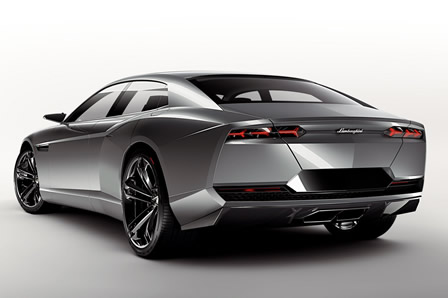
• BEST IN SHOW: Lamborghini Estoque -- "While the design is somewhat contrived, the Estoque really has presence when you see it in person. This is the car people will clearly remember," said Mandel.
• Contenders for Best of Show -- Ferrari California, Saab 9-X Air and BMW 7-series
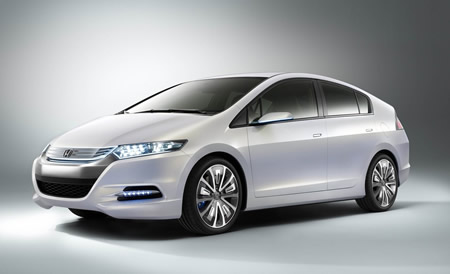
• MOST SIGNIFICANT: Honda Insight -- "This hybrid car will be cheaper than the Prius, have high fuel economy and seating for five. Honda has officially returned to the game they used to own."
• Contenders for Most Significant -- Audi A1 Sportback, Pininfarina Bollore, Mercedes Fascination and Volkswagen Golf
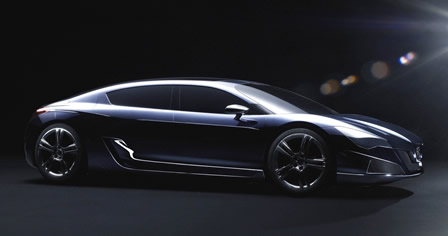
• BEST CONCEPT: Peugeot RC HyMotion4 -- "If the French automakers were to come to the U.S., this is the car Americans would want. Here is an electric sports car we can love."
• Contenders for Best Concept -- Honda Insight, Mercedes Fascination, Audi A1 Sportback and Saab 9-X Air
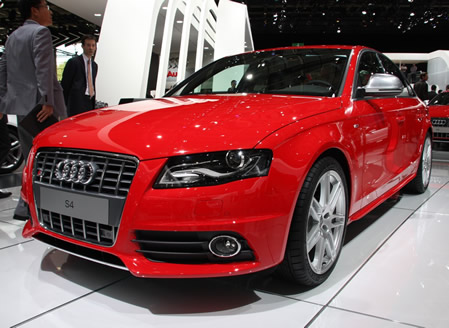
• MOST FUN: Audi S4 -- "The S4 is a rocket ship that is fun and fuel efficient. It satisfies on all fronts."
• Contenders for Most Fun -- Fiat 500 Abarth Essesse, Ferrari California, Volkswagen Golf GTI and Lexus IS250C
AutoWeek is America's only weekly automotive enthusiast magazine. For more than a decade, the editors of this weekly have been selecting winners in four categories (1) Best in Show, (2) Best Concept, (3) Most Significant and (4) Most Fun at auto shows in Detroit, Geneva, Paris, Frankfurt and Tokyo.

"At the world's top auto shows, AutoWeek has been selecting winners in four categories - Best in Show, Best Concept, Most Significant, and Most Fun. These categories cover all types of cars displayed there. Yet, taking note of the new circumstances in which the automobile industry finds itself today, AutoWeek editors could consider adding another category, such as - Most Handy or Best Handy."
© GlobalGiants.Com
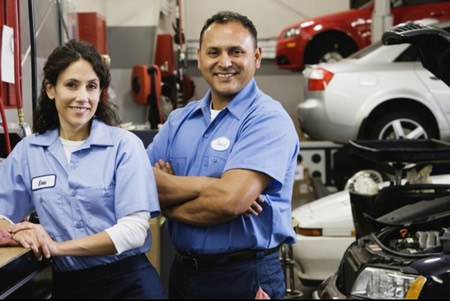
"With U.S. automakers reporting their worst monthly sales results of the year and no signs of relief expected in 2009, we now believe that as many as 100,000 industry-related jobs may be at risk.
With a more than 2 million unit sales decline likely this year compared with 2007, followed by a prolonged slump expected next year, the downturn is placing unforeseen levels of stress on the industry, we expect many players do not have the cash, credit or means to see the cycle through.
The last three quarters have seen a sharp curtailment in leases, high commodity and energy costs, a tightening of credit and rising unemployment. Consumers are fatigued, and we see more of the same in 2009 based on our read of the underlying industry fundamentals.
Only a resurgence in consumer confidence, stable financial markets, a resumption in the free flow of capital and a revitalized construction/real estate market can mitigate the downside risk."
- Grant Thornton LLP Corporate Advisory and Restructuring Services
|GlobalGiants.com|
Edited & Posted by the Editor | 10:48 PM | View the original post
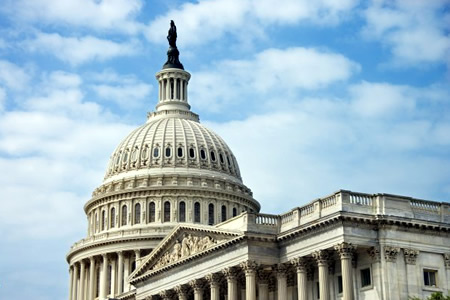
The International Franchise Association (IFA) today applauded the bipartisan economic rescue plan agreed to by congressional leaders and urged both the House and Senate to pass it quickly. The International Franchise Association is the world's oldest and largest organization representing franchising.

"We support the plan as outlined today by negotiators as a critical step in freeing up needed credit to help keep Main Street businesses operating and growing," said IFA Vice President of government relations David French. "Our members commend the extraordinary efforts by leading policymakers over the weekend to bring this important legislation together. The addition of crucial oversight and taxpayer safeguards strengthens the plan, and the package should send a positive signal to the financial markets and bring stability to the U.S financial system."

The franchised business sector is made up of locally owned businesses that create 21 million jobs and contribute $2.3 trillion to the private sector economy. Thousands of IFA members made their views known to congressional leaders this weekend with the message to come together on a bipartisan plan to bring stability to our nation's financial markets.
"We are grateful that our views and the views of thousands of small businesses across the country were heard," French said. "Now, Congress should pass the bill quickly and get it to the President for signing."
• Other Voices:

"Workers will not accept their tax dollars being turned over to the fat cats who took multi-million dollar bonuses and then bankrupted their companies and now threaten our entire economy. Action on the bailout will shape the votes of working Americans in November."
- Anna Burger, Chairperson, Change to Win. [Change to Win, 1900 L Street, NW Suite 900, Washington, DC 20036, USA, is one of the largest organizations of working Americans.]

"This massive bailout is nothing short of a scheme by irresponsible corporate pirates to privatize gains and socialize debt. Such a move will only further add to the burden of individuals and families, who are already struggling to make ends meet. Not one of our tax dollars should go toward rescuing an industry that is failing because of unregulated lending and trading practices.
We are tired of giving golden parachutes to greedy corporate interests. We're standing up and saying, 'Not this time, not with my money and not with my consent'."
- Cindy Sheehan, Candidate for Congress.

"Proposed $700 Billion Bailout Is Too Little, Too Late to End the Debt Crisis; Too Much, Too Soon for the U.S. Bond Market: The proposal before Congress for a $700 billion financial industry bailout will not only fail to end the massive U.S. debt crisis but could actually aggravate the crisis by driving up interest rates.
Based on recently released FDIC and Federal Reserve data, Weiss Research finds that:
1. 1,479 U.S. banks and 158 U.S. thrifts are at risk of failure, with total assets of $3.2 trillion, or 41 times the assets of banks on the FDIC's list of troubled institutions.
2. Among those with $5 billion or more in assets, 61 banks and 25 thrifts are heavily exposed to nonperforming mortgages.
3. The bailouts announced and proposed to date, although expected to cost over $1 trillion, are too small to rescue most institutions at risk, let alone address multiple problems with U.S. interest-bearing debts outstanding of $51 trillion and derivatives held by U.S. banks of $180 trillion.
There should be no illusion that the $700 billion estimate proposed by the Administration will be enough to end the crisis. Nor should there be any false hopes that the market for U.S. government securities can absorb the additional burden of a $700 billion bailout without putting major upward pressure on U.S. interest rates, aggravating the very debt crisis that the government is seeking to alleviate."
- Weiss Research, Inc. [Weiss Research, Inc., 15430 Endeavour Drive, Jupiter, FL 33478, USA.]

"Members of Congress are being asked to come together in a bipartisan effort to deal with an unprecedented financial crisis that threatens the stability of the global economy. For good reason, many are reluctant to take abrupt and dramatic action without giving due consideration to the long-term implications. This caution and thoroughness is appropriate. But it does not diminish the need to take convincing action very soon.
• There will be a time for investigation and the assessment of blame and guilt. This is not it.
• There will be a time to re-balance the powers of the executive and legislative branches of government. This is not it.
• There will be time to ensure government is not intruding unimpeded into the realm of private markets. This is not it.
The objections of lawmakers and many in the public to news of the "bailout" on the grounds of political philosophy and legislative oversight, and pure fear of government growth are legitimate and worthy. But the urgency of the situation -- the possibility of economic chaos and all that would mean -- is also legitimate.
What the economy requires immediately is first aid -- not long-term care. A first responder deals with the "ABCs" -- "airway, breathing and circulation." The same triage is required for the global economy. We are choking on bad debt and in real danger of the complete loss of financial circulation. We have to get the economy breathing again and world markets circulating freely. Then we can deal with everything else.
We do not have the leisure to stand over the victim arguing about who is to blame for the injury or who is going to pay for the treatment. That must come after we know the victim will live."
- Pennsylvania Business Council. [Pennsylvania Business Council, 116 Pine Street, Suite 201, Harrisburg, Pennsylvania 17101, USA.]

"It's fine to hope for the best, but we should budget for the worst. While the intent of this plan is to recoup much, if not all, of the initial cost to taxpayers there are no guarantees. The value of the assets to be purchased is highly uncertain. What we know for certain is that the government will incur a huge upfront cost, immediately adding to the debt and immediately incurring compounding interest payments. All of this will be layered on top of a deficit expected to exceed $500 billion next year, and an overall fiscal policy that is unsustainable. Meanwhile, we are borrowing increasing amounts from abroad to make up for our inability to make crucial budgetary decisions. The answer to every problem in Washington seems to be more debt. That simply cannot go on. Given the uncertainty of the return on this $700 billion of new borrowing, and the daunting challenges already confronting the fiscal outlook, Congress should adjust budget policy either though phased-in spending cuts or tax increases to ensure against any permanent fiscal deterioration.
Washington can normally act in the face of a crisis. We don't need to relearn that lesson. A more fundamental issue is whether we can learn from the current crisis and finally break the pattern of routinely ignoring long festering problems. It is no secret that our nation is entering an unprecedented and permanent demographic transformation to an older society and that we are doing so with steadily rising health care costs and steadily falling national savings. This is a dangerous combination for the future health of the economy. And yet, nothing in the budget process requires Congress to review the current-law outlook beyond the next five years, much less take corrective action. If we learn from Wall Street's mistakes, we can act more effectively, with less pain, and more time to prepare the public for difficult but necessary choices. If we don't change course, the federal government itself will be in need of a bailout."
- Robert L. Bixby, Executive Director, The Concord Coalition. [The Concord Coalition, 1011 Arlington Blvd., Suite 300, Arlington, VA 22209, USA.]
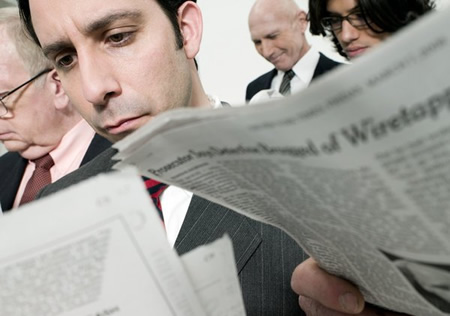
"As you know, about a week and a half ago, the Administration visited Capitol Hill and described the crisis in our financial markets and in our economy. A couple of days later, they presented us with their legislation, and since then we have worked in a bipartisan way to improve that legislation. We've entered into those conversations in the spirit of bipartisanship, with the understanding that each side would have half of our votes to pass the bill.
Today when the legislation came to the floor, the Democratic side more than lived up to its side of the bargain. While the legislation may have failed, the crisis is still with us.
Some of the issues that we worked on with the Republicans to improve the initial legislation related to oversight and protecting the taxpayer as we stabilize the markets. It was about ownership and equity in return for some of the investments that were made. It was about forbearance for homeowners so they could stay in their home. It was about corporate pay and how that had no more golden parachutes, and it was also about, again, oversight, oversight, oversight. I think these were major improvements to the bill, and as I say, they were bipartisan.
Again, the Administration pressed upon us the seriousness of this crisis in terms of the markets. We know how serious this is in terms of the middle class in our country. Whether it's a question of credit for small businesses or homeowners, for protecting savings for people, their penchants for retirement, for the education of their children. Keeping the store on the corner open to service the needs of the people in the neighborhood. America's communities have been feeling the downturn in the economy for a very long time...
The President impressed the Members about the gravity of the situation; that action is necessary to stabilize the markets and to protect the taxpayer.
Clearly, that message has not been received yet by the Republican Caucus. But again, we extend a hand of cooperation to the White House, to the Republicans, so that we can get this issue resolved for the benefit of America's working families, to strengthen our economy, and therefore strengthen our country...
So again, the legislation has failed but the crisis has not gone away. We must work in a bipartisan way, in order to have another bite of the apple, in terms of some legislation."
- Nancy Pelosi, Speaker of the House of Representatives, after the House rejected the Bailout Package 228-205 on Monday, September 29, 2008.
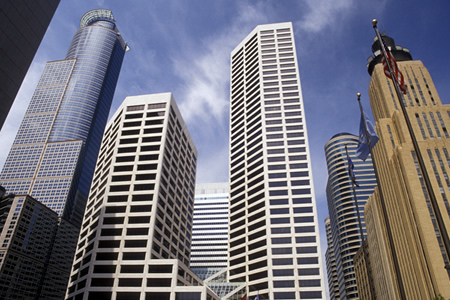
"September 29, 2008
TO THE MEMBERS OF THE UNITED STATES CONGRESS:
The U.S. Chamber of Commerce, the world's largest business federation representing more than three million businesses and organizations of every size, sector, and region, urges Congress to immediately pass the bipartisan financial rescue package to stem the financial panic. Congress must not adjourn without taking action to stabilize the financial markets.
Today's failure to approve legislation addressing the financial crisis has resulted in uncertainty and turmoil that have dramatically affected the markets, and lowered equity prices, eroding individual savings and destroying billions of dollars of household wealth.
Make no mistake: when the aftermath of Congressional inaction becomes clear, Americans will not tolerate those who stood by and let the calamity happen. If, on the other hand, Congress supports a plan to successfully restore the financial system and preserve the flow of credit to the economy, the American people will recognize that act of courage.
The Chamber urges Congress to immediately pass financial rescue legislation. The Chamber will score votes on, or in relation to, this issue in our annual How They Voted scorecard.
Sincerely,
R. Bruce Josten"
- U.S. Chamber of Commerce. [U.S. Chamber of Commerce, 1615 H St NW, Washington DC 20062, USA.]
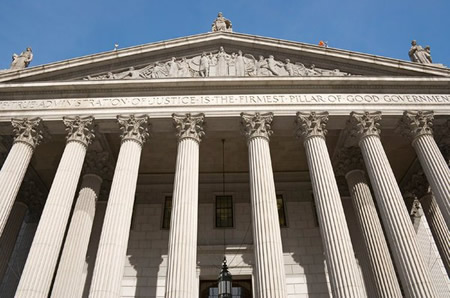
"Over the last decade, U.S. Chamber of Commerce has spearheaded and accelerated the movement for less corporate accountability and less regulation. During this same time period, there have been major corporate fraud convictions, accounting scandals, and the biggest economic crisis since the Great Depression at a great cost to the American people.
The current financial crisis was caused by U.S. Chamber's aggressive lobbying to eliminate accountability and oversight. Today, U.S. Chamber is the loudest supporter of a $700 billion taxpayer bailout, even though it spent the last decade fighting to eliminate corporate accountability -- one of the major factors that led to the current financial crisis.
U.S. Chamber has been paid millions by large corporations to limit the rights of shareholders, roll back Sarbanes-Oxley reforms, prevent disclosures to investors, and protect boardrooms while preventing consumers from holding them accountable.
U.S. Chamber of Commerce has sought to destroy any check on corporate excess, accountability and greed. By conducting the dirty work of Enron, Exxon, AIG, and a host of other negligent corporations, U.S. Chamber has put countless Americans in financial jeopardy."
- American Association for Justice. [American Association for Justice, 777 6th Street, NW, Washington, DC 20001, USA (formerly known as the Association of Trial Lawyers of America), is the world's largest trial bar.]
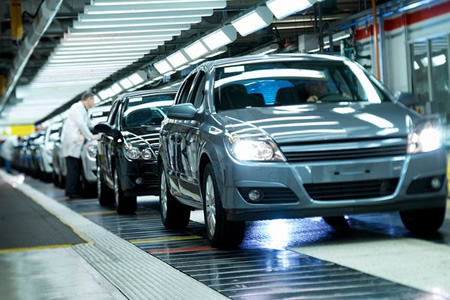
"On behalf of our ten member companies representing nearly 80% of the U.S. new car sales market, the Alliance of Automobile Manufacturers strongly urges Congress and the Administration to come together swiftly to stabilize the credit market.
• For many Americans, after their homes, automobiles are the largest purchase they will ever make.
• With more than 90% of all new vehicles financed with credit it is crucial to our industry's survival that consumers have the ability to borrow money.
• This financial crisis not only compromises the vitality of our companies but also, and more importantly, the one in ten Americans whose jobs are supported by the auto industry, including suppliers, dealers and small businesses. Immediate action is imperative.
• We commend the bipartisan leadership of Congress and the Administration for their efforts to craft a compromise and urge Congress to quickly pass, by the end of this week, a financial rescue package that aids both the credit markets and the ability of consumers to finance vehicle purchases."
- Dave McCurdy, President and CEO, Alliance of Automobile Manufacturers. [The Alliance of Automobile Manufacturers is a trade association of 10 car and light truck manufacturers including • BMW Group, • Chrysler LLC, • Ford Motor Company, • General Motors, • Mazda, • Mercedes-Benz USA, • Mitsubishi Motors, • Porsche, • Toyota and • Volkswagen. Formed in 1999, the Alliance serves as a leading advocacy group for the automobile industry on a range of public policy issues.]
|GlobalGiants.com|
Edited & Posted by the Editor | 10:21 PM | View the original post
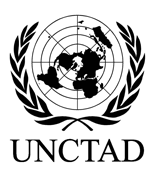
The economic downturn and financial instability have made the largest transnational corporations (TNCs) more cautious about their medium-term foreign direct investment (FDI) ambitions, UNCTAD´s World Investment Prospects Survey 2008-2010 reports.
The percentage of companies planning large increases in investment overseas over the next three years has dropped significantly from 2007. The annual survey, known as the WIPS (World Investment Prospects Survey), was released yesterday in Geneva, Switzerland, in conjunction with the World Investment Report 2008. WIPS results are based on 226 responses to queries sent to the world´s largest TNCs.

The survey indicates that a majority of respondent companies still plan to increase their international investment expenditures, albeit at a more moderate level, over the next three years. This is largely due to an underlying and persistent trend towards expanding the share of TNC production, employment, and sales abroad. This trend towards internationalization will affect all corporate functions, including research and development (R&D) and decision-making centres, which so far have tended to remain in TNCs´ home countries.
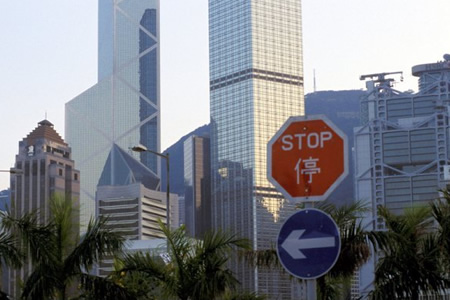
Analysis by home region shows the quickly growing international ambitions of companies from the developing world, particularly Asia, while FDI prospects for companies from developed countries, especially North American and Japan, have dimmed as compared to a year ago. Although still very focused on investing in their home regions, companies are expressing a growing interest in "far-shore" investments, providing evidence of a gradual extension of their strategic scope.

Five very large countries are considered by large TNCs as the most attractive destinations for future foreign investment: China, India, the United States, the Russian Federation, and Brazil. Their rankings are unchanged from last year´s survey. However, the Russian Federation and Brazil have caught up noticeably in attractiveness. It is noteworthy that four of the five top destinations are the emerging economies known collectively as BRICs (Brazil, Russia, India, and China).
Among the top 15 destination countries, Viet Nam again ranks 6th; Germany and Indonesia have improved to 7th and 8th, respectively. Australia, the United Kingdom, Poland, and France have declined slightly in the rankings but still remain in the top 15. Newcomers to the top 15 are South Africa, Canada, and Turkey.
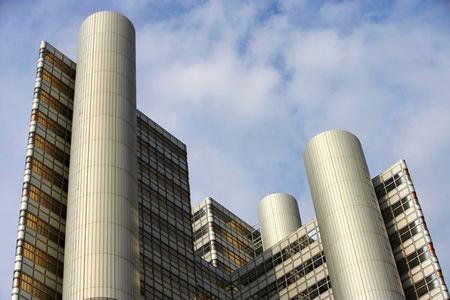
Market growth, market size, and access to international/regional markets are by far the most important factors influencing companies´ choices of investment location (50% of answers combined), followed by quality of business environment, including availability of skilled labour (8%), suppliers (6%), and adequate infrastructure (7%). The legal environment and government effectiveness were also mentioned frequently by TNCs responding to the survey. Availability of cheap labour, although not a negligible factor on average (8% of responses), appears to be a major determinant only for a few labour-intensive manufacturing activities such as garment production.
The World Investment Prospects Survey 2008-2010 is the most recent of a series of surveys on FDI prospects. UNCTAD has carried similar surveys since 1995.
In performing its functions, United Nations Conference on Trade and Development (UNCTAD) works together with member Governments and interacts with organizations of the United Nations system and regional commissions, as well as with governmental institutions, non-governmental organizations, the private sector, including trade and industry associations, research institutes and universities worldwide.
Source: United Nations Conference on Trade and Development (UNCTAD), Palais des Nations, 8-14, Av. de la Paix, 1211 Geneva 10, Switzerland.
|GlobalGiants.com|
Edited & Posted by the Editor | 1:02 AM | View the original post

According to the J.D. Power and Associates 2008 Escaped Shopper Study(SM) released today, majority of vehicles are rejected only after a new-vehicle shopper has visited a dealership,
The study, which analyzes the reasons why consumers consider a model but ultimately purchase a different make or model, finds that 80 percent of vehicles are rejected after a new-vehicle shopper has visited a dealership.

Three dealer-related issues are among the top reasons for not purchasing a vehicle:
(1) Another dealer has better service.
(2) Limited availability of the specific vehicle shoppers are looking for on dealer lots.
(3) Lack of professionalism among personnel at the dealership.

"Given today's challenging automotive market, both sales and service experiences at the dealership are particularly critical in the decision-making process of shoppers," said Tom Gauer, senior director of automotive retail research at J.D. Power and Associates. "Sales personnel can play a key role in improving close rates by viewing customer visits as an opportunity to demonstrate a vehicle's value and by successfully matching shoppers with the new vehicle that best suits their needs."
The study also finds that an increasing number of shoppers have considered buying an Asian brand -- 63 percent in 2008, up from 60 percent in 2007. Conversely, the proportion of shoppers who considered buying a domestic (American) brand has decreased -- down to 55 percent in 2008 from 58 percent in 2007. Shoppers who cross-shop among Asian and domestic brands are more likely to purchase an Asian brand and most often cite retained value, reliability and gas mileage as primary reasons for their choice. In contrast, those customers who purchase a domestic (American) brand instead of an Asian brand most commonly cite a desire to "buy American" as their primary reason for purchase, followed by rebates and incentives offered, and vehicle price.

"As shoppers move away from larger-vehicle segments in growing numbers, domestic (American) manufacturers -- more so than Asian and European manufacturers -- must focus on rapidly aligning their U.S. product portfolios with this shift in consumer preferences," said Gauer.
The percentage of shoppers who cite gas mileage as a reason for rejecting a vehicle has increased in 2008-up to nearly 20 percent this year from nearly 17 percent in 2007. Unsatisfactory gas mileage is the third-most-common reason to reject a vehicle, with particularly high rates of rejection in the large, midsize and compact utility vehicle segments.
Nearly 40 percent of all new-vehicle shoppers cite price as the most influential reason for not purchasing a vehicle. Additionally, nearly one-half of shoppers 40 years of age and younger reject vehicles based on price- or finance-related issues. In contrast, only one in three shoppers who are 60 years of age or older reject vehicles for the same reasons.

"Interestingly, nearly 40 percent of all shoppers who reject a vehicle because of price say they can afford the vehicle, but don't believe the vehicle is worth the price," said Gauer. "This presents an opportunity for dealership personnel to focus on demonstrating the different features contributing to the vehicle's total value to these shoppers, which can eventually lead to increases in close rates."
• J.D. Power's "2008 Escaped Shopper Study" is based on responses from 29,903 new-vehicle buyers surveyed between May and July 2008.
Source: J.D. Power and Associates
"This is a very useful report from J.D. Power. The crucial point that emerges from this study is that when an auto maker advertises its products in the media or displays them at auto shows, it is only half the marketing done. And this half the marketing done is no marketing done at all till it is hundred percent completed via the franchisee auto dealers.
Success in retail auto sales isn't an easy process and turnover is constantly an issue. With vehicle pricing readily available in newspapers, other publications and online, consumers quickly decide what make and model of vehicle they want to buy. Today, more and more consumers are using the Information Superhighway to find reviews and ratings of dealerships and their employees. As a result, the best local sales and service professionals have been elevated by their customers and are being promoted online as well as offline. As what a global Internet survey by Nielsen found, more than 80 per cent of those who use the Internet trust others' advice rather than any kind of advertising, proving that word-of-mouth is the most powerful advertising tool. Newspapers come second in the 'most trusted list'.
Since a dealer's good or bad reputation is instantly transferred to the automobile manufacturer, most of the remaining marketing to be done by an auto maker should consist of bringing about 'word of mouth' recommendations about its dealers. To make that happen and to make its marketing hundred percent complete and successful, it is essential that the car maker constantly reviews dealer performance and sees how it can help its dealers in keeping their salespersons courteous and professional."
© GlobalGiants.Com
|GlobalGiants.com|
Edited & Posted by the Editor | 12:24 PM | View the original post
On Tuesday, October 28th, Columbia Records will release two special edition CDs featuring career-spanning repertoire from Celine Dion, one of the biggest selling female artist of all time.

"My Love...Essential Collection" is a single disc featuring 17 songs, consisting of Celine's biggest hits...songs such as the international chart-topper "All By Myself", "Where Does My Heart Beat Now", her landmark 1996 Olympic Ceremonies performance of "Power of the Dream, the brand-new never-released "There Comes A Time," and a live recording of the lead track "My Love."
"My Love" is a semi-autobiographic song recently written for Celine by Linda Perry (Christina Aguilera, Dixie Chicks, Gwen Stefani) and has become a show-stopper every night during Celine's sold-out World Tour, which is currently in flight across North America. "My Love" impacts at radio on September 22nd.
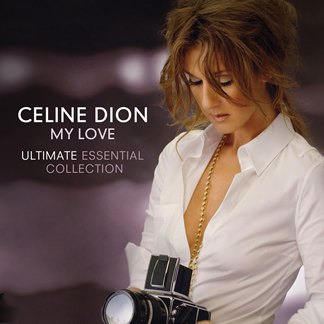
The two-disc edition, entitled "My Love...Ultimate Essential Collection," is a 26 song set that has been further expanded to include rarities like "(You Make Me Feel Like A) Natural Woman," "The Prayer" (a duet with Andrea Bocelli), "Tell Him" (a duet with Barbra Streisand), "I Knew I Loved You," "Dance With My Father", and "Pour que tu m'aimes encore" (the biggest song of Celine's French career).
Celine's "My Love..." anthologies cover virtually every single aspect of her extraordinary career, including fan favorites, a definitive assemblage of chart-topping international successes, as well as new and unreleased recordings culled from once-in-a-lifetime experiences that Celine has participated in over the years.
• Celine Dion - "My Love...Essential Collection" - single disc edition:
According to Columbia Records, "Celine Dion is the biggest-selling Female Artist of All Time, with worldwide album sales of over 200 million. Her RIAA Diamond Award albums "Falling Into You" and "Let's Talk About Love" have each sold over 30 million worldwide. She has five Grammys -- Best Pop Vocal Performance ("Beauty and the Beast"); Album of the Year & Best Pop Album ("Falling Into You"); Record of the Year & Best Female Pop Vocal Performance ("My Heart Will Go On") and two Best Song Oscars ("Beauty and the Beast" & "My Heart Will Go On")."
Source: Columbia Records
|GlobalGiants.com|
Edited & Posted by the Editor | 1:11 PM | View the original post
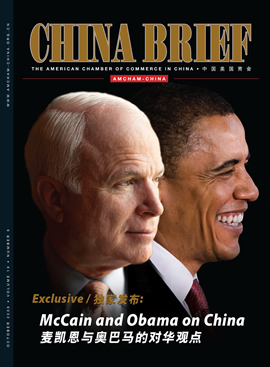
Photo: John McCain, Barack Obama Outline China Views Through AmCham-China.
The American Chamber of Commerce in China (AmCham-China) today announced in Beijing that US presidential candidates John McCain and Barack Obama have outlined their views on what US-China relations would be like under their respective administrations in articles written exclusively for AmCham. The articles, to be published in the October issue of AmCham-China's monthly magazine, China Brief, are believed to represent the first time the two candidates have publicly offered substantive details about their proposed China policies.
AmCham-China is a Beijing-based, non-profit organization representing the interests of some 2,700 companies and individuals doing business throughout China.
The articles outline the candidates' positions on a range of critical China-related business and policy issues facing the next US administration including trade balances, currency, security and the environment, as well as their thoughts on US competitiveness in the world economy.
"The fact that senators McCain and Obama chose to share their insights first with AmCham members is a testament to the chamber's reach and standing as an advocate for positive US-China business relations," said AmCham-China Chairman James Zimmerman. "We are encouraged to see both candidates call for further business development and more US engagement -- rather than isolationism -- in the years ahead. As a non-profit, non-partisan organization, AmCham-China looks forward to continuing good relations with the next administration."
Among many topics addressed, both candidates lay out clear indications of their views on trade.
For example, in his article Senator Obama writes that he will "undertake more sustained and serious efforts to combat intellectual property piracy in China, and to address regulations that discriminate against foreign investments in major sectors and other unfair trading practices." In addition, the senator pledges to work with China's leaders "to establish a better system for both countries to monitor products produced for export and act when dangerous products are identified."
Meanwhile, Senator McCain stresses China's obligations in improving bilateral trade relations. China's "commitment to open markets must include enforcement of international trade rules, protecting intellectual property, lowering manufacturing tariffs," he writes. "The next administration should be clear about where China needs to make progress, hold it to its commitments through enforcement at the World Trade Organization, and enforce US trade and product safety laws."
Source: The American Chamber of Commerce in China
|GlobalGiants.com|
Edited & Posted by the Editor | 5:17 AM | View the original post
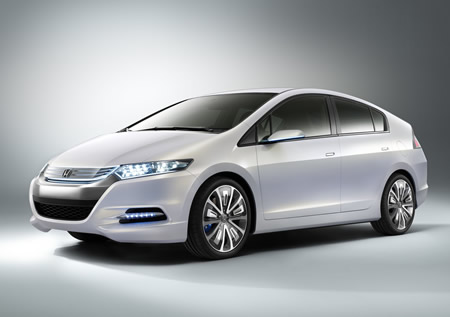
Photo: Honda will reveal a concept version of its new small hybrid vehicle, to be named Insight, at the 2008 Paris International Auto Show, October 2, the company announced.
Honda has announced that it will reveal a concept version of its new small hybrid vehicle, to be named Insight, at the 2008 Paris International Auto Show on October 2.
Honda further said that "Insight" would go on sale in the U.S. next spring and the all-new purpose-built Insight will come to market at a price significantly below hybrids available today. And from this unique position in the marketplace, the Insight will advance the affordability and accessibility of hybrid technology to a new generation of buyers. The new Insight Concept shares styling cues with the Honda FCX Clarity fuel cell vehicle, Honda explains.
"The original Honda Insight pioneered hybrid technology in the U.S. and remains a symbol of Honda's commitment to innovative technology and fuel efficiency," said Takeo Fukui, Honda Motor Co., Ltd. CEO. "This new Insight will break new ground as an affordable hybrid within the reach of customers who want great fuel economy and great value."
The production Insight will be offered as a five-door, five-passenger hatchback. Along with the Civic Hybrid, the new vehicle will be produced at an expanded hybrid vehicle production line at the Suzuka factory in Japan.
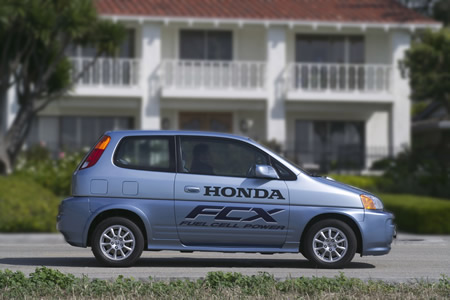
Photo: Honda FCX Clarity
Honda claims, "The Insight Concept is a small, fuel efficient hybrid car that delivers big style and functionality with a healthy dose of fun." "The Insight Concept defines a new stage in the evolution of hybrid technology resulting in a new level of affordability for hybrid customers worldwide. Evoking the innovative styling cues first seen in the FCX Clarity, the Insight Concept is designed with a low center of gravity and a generous five-passenger cabin. While the Insight Concept's aerodynamic design identifies its fuel efficient purpose, its five-door access and folding rear seats speak to functionality that is designed to meet the needs of customers with an active lifestyle," the company adds.
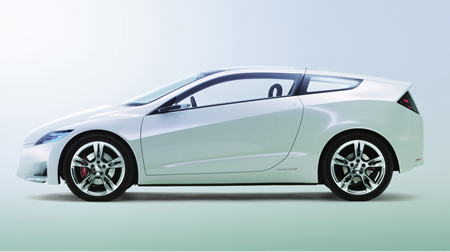
Photo: Honda CR-Z Concept
According to Honda, the Insight is expected to have annual global sales of 200,000 units per year -- approximately 100,000 in North America. Following the launch of the new Insight, Honda also plans to introduce another sporty hybrid vehicle based on the CR-Z. "All together, Honda's global sales of hybrids should increase to approximately 500,000 units a year, or more than 10 percent of its total worldwide annual automobile sales," says Honda.
Source: Honda
"Honda's expectation to have annual global sales of 200,000 units of "Insight" per year (approximately 100,000 in North America), and its global sales of hybrids increasing to 500, 000 units a year, is no ordinary news. It deserves to be analyzed by other car makers -- Toyota, GM, Ford, Suzuki, Daimler, Nissan, Hyundai,..." - GlobalGiants.Com
|GlobalGiants.com|
Edited & Posted by the Editor | 9:08 AM | View the original post
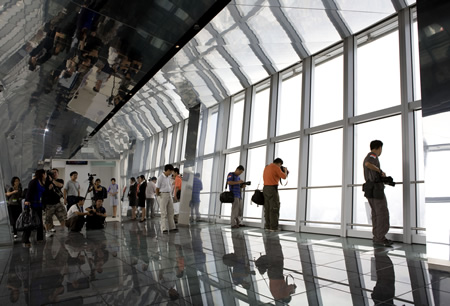
Photo: Journalists enjoy a spectacular bird's eye view across Shanghai from the observatory deck on the 100th floor of Shanghai World Financial Centre. The observatory deck, the highest in the world, offers sweeping vistas right across the city and features a special 50m-long glass floor that provides a unique perspective on the city, and the thriving district of Pudong below. It opens to the public on August 30th, 2008.

Photo: Mr. Minoru Mori (middle in the front), President and CEO of Mori Building, shows a scale model to the VIPs at the opening press conference of this landmark building. Shanghai World Financial Centre measures 492 meters and boasts 101 floors. Mr. Minoru Mori described the building as a "global magnet for finance, information and talent".
Edited & Posted by the Editor | 10:02 AM | View the original post
TV One commentator Roland Martin's interview with Mrs. Obama to serve as prelude to TV One's live coverage of the Democratic convention beginning Monday, Aug. 25 at 8 PM ET USA
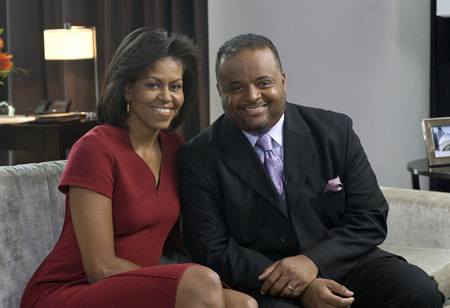
TV One, a new cable and satellite television network, programming primarily to African American adults has interviewed Michelle Obama who sits down with TV One commentator Roland Martin to discuss a wide range of topics that provide a personal glimpse of the presumptive Democratic Presidential candidate's spouse, her relationship with her husband and family, and what she thinks about the historic role into which they have stepped. The show (In Conversation ... The Michelle Obama Interview) will be broadcast on Sunday, August 24 from 8-9 PM ET USA on TV One.
According to TV One announcement, during this revealing interview, which repeats at 11 PM ET, Martin talks to Mrs. Obama about a host of topics, including her role in the campaign, how she deals with political attacks, the challenges of being away from their children on the campaign trail, how they find time for family and each other, her faith and their decision to leave Trinity Church, life in a fishbowl, how her upbringing shaped her values, and people's perceptions and misperceptions about her.
Mrs. Obama tells Martin that she spent much of her marriage trying to talk her husband out of politics, but she says her daughters are at the heart of the reason she decided to support his desire to pursue public office -- because she recognized that through politics he could make a better world for them.
She says that a spouse's role in the campaign is important because it gives a broader insight of who the candidate is.
"So much of who I am is where I grew up," Mrs. Obama says. She talks about growing up on the South Side of Chicago, her father as a shift worker who had MS and who believed in sacrificing for his family but never complained. She says both her parents taught her the importance of working hard and giving back.
She also believes voters can see themselves reflected in her and her husband's working and middle class family backgrounds. She says that black women, in particular, have not had their views and their lives reflected in the larger world, and she is delighted when she hears from black women that they see themselves reflected in her.
She tells Martin she and her husband learned how to sustain their relationship back in his state senate days, including carving out a regular date night. She says it's important for her daughters to see their parents' loving relationship, to see them holding hands, and that it helps them feel secure and loved.
While her own schedule is hectic, she recognizes that the average working family faces much more difficult struggles, with every woman she knows struggling to balance resources. She tells Martin that she passionately wants to give voice to the challenges of working families, especially military families, who struggle with housing, schools, and health matters, many of them barely getting by.
Mrs. Obama says that it's truly humbling to be part of the next step in history, and she clearly does recognize that they are part of a historic moment.
"You need to celebrate what [Sen. Obama] represents even if you don't vote for him," Mrs. Obama says.
The interview, conducted in Chicago on Aug. 20, is part of TV One's continuing series of hour-long interviews with major public figures of interest to African Americans. Over the past four years, TV One has featured hour-long interviews with Senators Barack Obama and Hillary Clinton, then- Secretary of State Colin Powell, then-National Security Adviser and current Secretary of State Condoleezza Rice, Supreme Court Justice Clarence Thomas and former Secretary of Education Roderick Paige.
"We are delighted to bring this interview with Mrs. Obama to our viewers as part of our public affairs programming during the Presidential election season," said TV One President and CEO Johnathan Rodgers. "We also hope to have an opportunity soon to offer our viewers an in-depth interview with Senator McCain," Rodgers added.
Source: TV One
|GlobalGiants.com|
Edited & Posted by the Editor | 1:06 PM | View the original post
 |
 |
